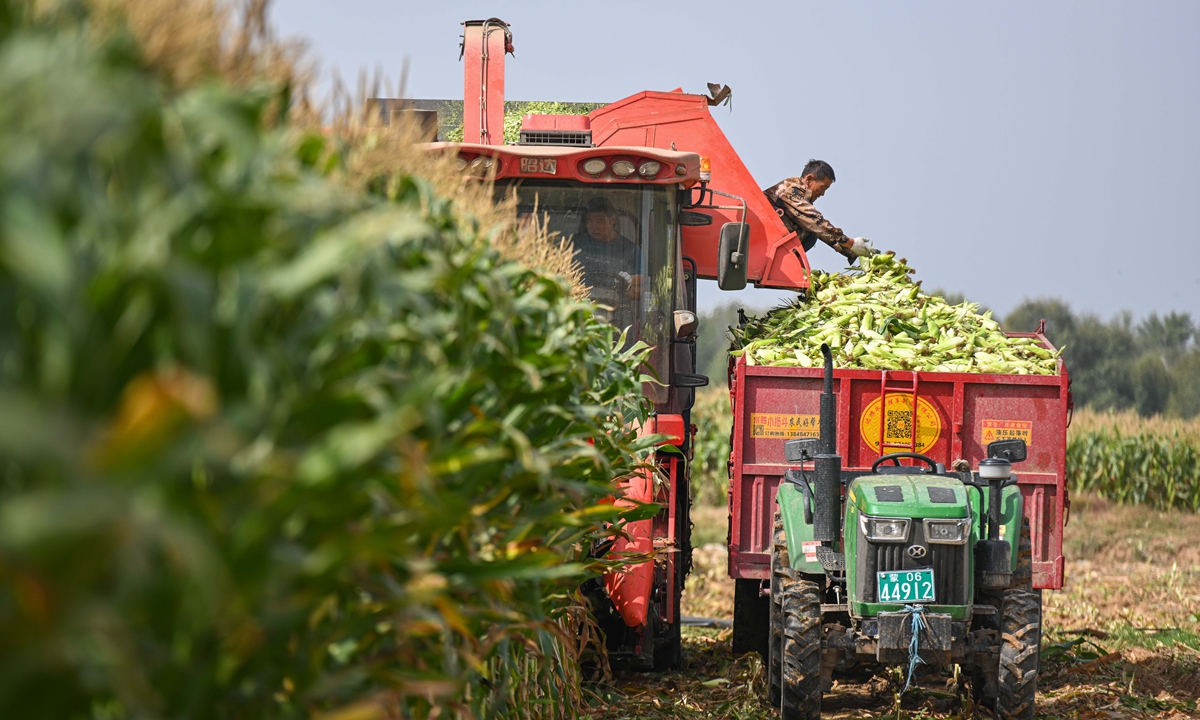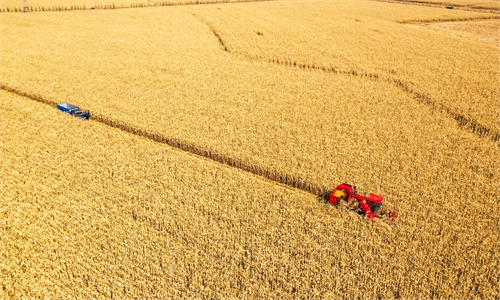CPC makes every effort to ensure food security and promotes rural revitalization: expert

A farmer drives a farm machine to harvest corn in Jungar Banner, North China's Inner Mongolia Autonomous Region, on September 20, 2022. Photo: Xinhua
With some 9 percent of the world's arable land, China needs to feed nearly one-fifth of the global population.
"Food security is among China's most fundamental interests. Over the past decade, China has steadily increased its grain production capacity, ensured national food security, and promoted rural revitalization by consolidating the foundation of agriculture, rural areas, and work related to farmers," Li Guoxiang, a research fellow at the Rural Development Institute of the Chinese Academy of Social Sciences, told the Global Times.
Issues concerning agriculture and farmers are of top priority to the Communist Party of China (CPC), Li said. He noted that the CPC's further deployment of plans for food security and rural revitalization in the report to the 20th CPC National Congress fully demonstrates the Party's profound understanding of the current international situation as well as China's national agricultural development conditions.
China has incorporated the implementation of the food security strategy into its outline of the 14th Five-Year Plan (2021-25). The outline calls for efforts to ensure absolute grain security and the supply of important sideline agricultural products, and the promotion of legislation concerning food security.
Li said that in the face of the complicated international situation exacerbated by the Russia-Ukraine crisis and the COVID-19 pandemic, China has firmly grasped the two key elements of agricultural development - strictly adhering to a "red line" of 1.8 billion mu (120 million hectares) of arable land, and accelerating the revitalization of the seed industry.
At present, over 95 percent of China's grain variety cultivation areas have been independently selected and bred. The Party and the country have also vigorously promoted the mechanization of the whole grain production process with the overall mechanization rates of wheat, corn, and rice cultivation exceeding 97 percent, 90 percent, and 85 percent respectively.
At the same time, over the last decade, the Party and the country have improved policies to support grain production, appropriately raising the minimum purchase prices for rice and wheat, and stabilizing production subsidies for corn and soybeans, Li noted. "These policies and measures ensure that farmers do not suffer financial liabilities from farming activities while their income steadily increases," he said.
According to China's National Development and Reform Commission, in the last two years, the central government has issued 60 billion yuan ($8.3 billion) in one-time subsidies to farmers to mitigate the impact of rising prices of agricultural supplies. At the same time, related government departments have vigorously developed socialized agricultural services to help small-scale farmers advance in grain production.
With regards to the grain industry supply chain, the government has further improved monitoring and implemented early warning systems, enhancing grain transfer, distribution, and emergency supply assurance capacities in recent years.
"Based on the historic victory in poverty alleviation, China has fully shifted to the new journey of the comprehensive promotion of rural revitalization in an all-rounded way. Among the areas showing promise are agricultural development and food security," he said.

